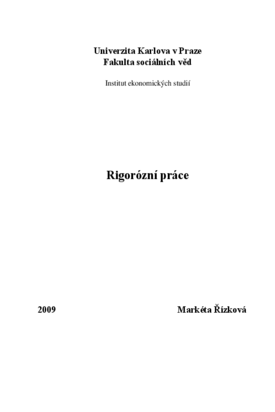Emission trading: evaluation of the European experience
Emission trading: evaluation of the European experience
rigorous thesis (DEFENDED)

View/
Permanent link
http://hdl.handle.net/20.500.11956/1639Identifiers
Study Information System: 188257
Collections
- Kvalifikační práce [18370]
Author
Advisor
Referee
Urban, Luděk
Faculty / Institute
Faculty of Social Sciences
Discipline
Economics
Department
Institute of Economic Studies
Date of defense
25. 3. 2009
Publisher
Univerzita Karlova, Fakulta sociálních vědLanguage
Czech
Grade
Pass
Cílem práce je podat komplexní pohled na mechanismus emisního obchodování a zaměřit se na diskutované oblasti fungování zvláště evropského systému emisního obchodování (EU ETS) jako příkladu největšího fungující zavedeného systému emisního obchodování. Základní přístupy analýzy jsou jak teoretické tak praktické. V teoretické části se zaměříme na porovnání aplikace emisního obchodování versus environmentálních daní a budeme diskutovat, kdy je lepší regulovat pomocí nástrojů zaměřených na cenu a kdy na regulaci množství. Dále se teoreticky zaměříme na metody alokace používané v emisním obchodování se zvláštním důrazem na alokaci pomocí aukcí, která je teoreticky nejvíce preferovaná. V praktické části provedeme analýzu alokačních metod v rámci Fáze 1 a Fáze 2 systému EU ETS a shrneme jaké jsou očekávané změny v systému EU ETS po roce 2012. Na závěr zhodnotíme výsledky alokace versus emise ve Fázi 1 (2005-2007) a na základě predikcí ekonomického růstu a emisní intenzity odhadneme další vývoj ve Fázi 2 (2008- 2012) a v následující fázi po roce 2012.
Our aim is to show complex picture and highlight the most discussed features of the emission trading and especially the functioning of the European System of Emission Trading (EU ETS) as a representative of the biggest functioning emission trading system. The key approaches involved in our analysis are both theoretical and practical. In the theoretical section we compare emission trading and environmental taxes and we discuss when it is better to regulate by price and when by quantity instruments. We will discuss the possible allocation methods and especially method of auctioning as the most theoretically preferred allocation method. The practical approach will tackle following two aspects: how the emission allowances have been allocated within the EU ETS in Phase 1 and Phase 2 and what the planned changes are in post 2012. Finally, we will look at the results of allocation versus emission during the first trading period in years 2005-2007 and how it might look in the future in Phase 2 and beyond..
